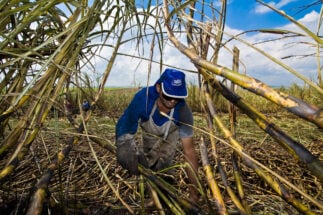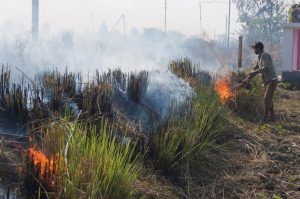Mukti Doley and his three friends covered their faces as they rowed next to Majuli—the world’s largest river island on the transboundary Brahmaputra river. The Covid-19 pandemic has made masks a common sight everywhere including in this relatively remote part of Assam in north-eastern India. But these fishers were covering their faces for another reason—to keep out the stench of rotting pig carcasses caught among the hyacinths near the riverbanks.
Instead of fishing, Doley and other fishers have been busy clearing the hyacinths so that the carcasses flow downstream.
Suspected to have been brought in by infected pig carcasses floating down the Brahmaputra from Tibet in China, an epidemic of African swine flu (ASF) that broke out in February has decimated the pig population in Dhemaji and Lakhimpur districts. Tangoni, Simen Chapori, Telam and Jonai in Dhemaji district are the areas that have witnessed most of the deaths in this region of traditional pig farmers.
![Carcass of a pig on Ranganadi river in Lakhimpur district on April 25 [image by: Farhana Ahmed]](https://dialogue.earth/content/uploads/2020/05/9.jpeg)
Thousands of carcasses have been floating down the rivers of the Brahmaputra basin. Tributaries such as Subansiri, Ranganadi, Dikrong, Jiyadhal, Sisi-Tongani, Charikodiya, Gainadi and Simen—and then the main river have been carrying carcasses that have often reached Jorhat, over 100 kilometres downstream. In some cases, carcasses have floated till Tezpur, almost 300 kilometres downstream.
![map of confluence of Siang-Dibang-Dihing [Google map adapted by Farhana Ahmed]](https://dialogue.earth/content/uploads/2020/05/Google-Map-1.jpg)
Besides posing a threat to the pork industry, ASF is severely impacting the rivers and other water bodies of this biodiversity-rich area due to improper disposal of carcasses. It is a major threat to aquatic life as well as domestic cattle that graze on the riverbanks.
ASF does not affect humans.
Swine flu of a new kind
“The animals first have rheumy discharges from their eyes, followed by fever and loss of appetite, before succumbing,” said Jogen Taid, a pig farmer who lost 25 animals in Laimekuri village of Jonai sub-division in Dhemaji. “We’ve never seen such problems among our pigs before.”
![Pig carcass stuck on Subansiri river near Dhunaguri Ghat, Lakhimpur district on April 26 [image by: Farhana Ahmed]](https://dialogue.earth/content/uploads/2020/05/12.jpg)
Feroze Doley, another pig farmer in Simen Chapori, said that the mortality rate of animals kept in captivity is relatively low compared to those that roam freely and eat everywhere.
The Animal Husbandry and Veterinary Department (AH&VD) of the Assam government first responded to the epidemic by vaccinating against Classical Swine Fever or hog cholera—a disease common to pigs in this region. But when the vaccinated animals kept falling ill and dying, the AH&VD sent blood samples to the National Institute of High Security Animal Diseases (NIHSAD) in Bhopal on April 29.
The results came on May 1, confirming the outbreak of ASF among the pigs dying in Assam and the adjacent state of Arunachal Pradesh. This is the first time this disease has been reported in India.
According to Office International des Epizooties (OIE), “African swine fever (ASF) is a highly contagious haemorrhagic viral disease of domestic and wild pigs caused by a large DNA virus of the Asfarviridae family, which also infects ticks of the genus Ornithodoros.” The OIE goes on to note that it “can be spread by live or dead pigs, domestic or wild, and pork products. Transmission can also occur via contaminated feed and fomites (non-living objects) such as shoes, clothes, vehicles, knives, equipment etc., due to the high environmental resistance of ASF virus. There is no approved vaccine against ASF.”
A devastating spread across East and Southeast Asia
Since 2018, the UN Food and Agricultural Organisation (FAO) has been monitoring the outbreak of ASF in Asia. Since it was first detected in August 2018 in China, 1.19 million pigs have been culled in the country. It had then spread to Mongolia, Vietnam, Cambodia, Laos, Myanmar, the Philippines, North Korea, South Korea, Timor-Leste, and Indonesia.
Defining ASF as “unprecedented global threat: a challenge to food security, wildlife management and conservation,” the FAO had scheduled a conference for affected countries in September this year. At that time, India was not one of the affected countries.
The virus has a long survival period, helping it spread easily. According to the FAO, it “remains infectious for months in pork products and more than 1,000 days in frozen pork. Humans play a major role in short and long distance introduction and spread of the virus.”
In India, the central agriculture ministry sent a warning to all state governments on June 10, 2019, saying ASF “is a matter of concern for India as there is movement of both live pigs and pork products into India from its neighbouring countries.” The advisory also said, “the border Indian states need to remain alert on the movement of live pigs and pork products into their territory. In this regard, the people in the border areas, especially in the northeast, require to be adequately sensitised.”
The Chinese connection
Some residents of Dhemaji heard of the epidemic in Tibet when they went on work to the India-China border this February. They were told of pig carcasses floating down the Siang river—the main stem of the Brahmaputra as it enters India from China. Many of the northern tributaries of the Brahmaputra also originate in Tibet. ASF broke out in Arunachal Pradesh and Assam within days of the first sightings of pig carcasses on the Siang.
Transboundary transmission of ASF through rivers is a possibility strengthened by reports of wild boar deaths in the area, specifically at Lidor Soyit on the upper ridge of the Sille river in East Siang district of Arunachal Pradesh. The reports surfaced on May 14.
One of the ways ASF is transmitted is through the wild boar population and the ticks that live off them. Transmission may have happened via wild boars as well.
Threat to Kaziranga
The Lidor Soyit case threatens the wild boar population of Kaziranga National Park, the world-famous home of the one-horned rhino. The Brahmaputra flows along the forest. Most families at a village adjacent to the park’s Agoratoli Range rear pigs and movement of domestic as well as wild boars is common in the area.
The park authorities have now dug a trench two metres deep and two kilometres long on the border in an effort to keep the populations apart.
![<p>A diseased pig in Gogamukh on the bank of Subansiri in Lakhimpur district, on April 27 [image by: Farhana Ahmed]</p>](https://dialogue.earth/content/uploads/2020/05/swine-flu-pig-1.jpeg)

![Indians wearing protective masks stand with their luggage in queue outside a railway station [image: Alamy]](https://dialogue.earth/content/uploads/2020/05/indians-protective-masks-300x200.jpg)





